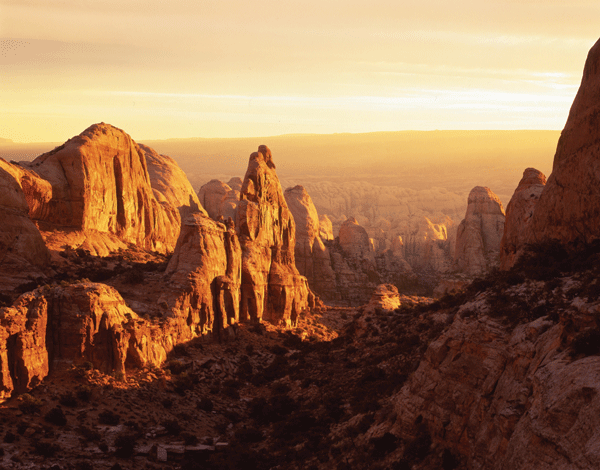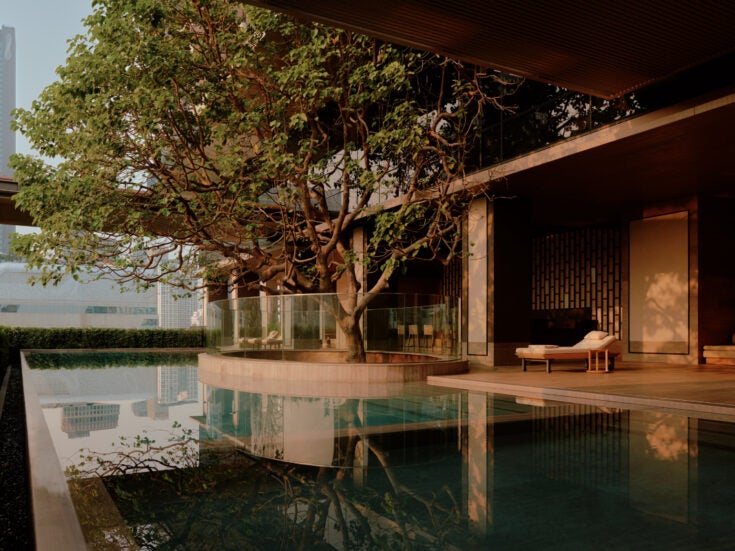
The blazing canyonlands of the US are alive with both geological and human history, and unforgettable vistas. Teresa Levonian Cole hits the trails.

Even if you have never heard of the Four Corners region of America — that majestic, otherworldly land where the arbitrary borders of Utah, Colorado, New Mexico and Arizona collide on the Colorado plateau — you are sure to have seen it on the big screen: a land of hallucinatory cliffs, gaping canyons and vast mesas. From Moab in Utah to Monument Valley in Arizona, rifle-toting cowboys and plumed, tomahawk-wielding ‘Indians’ have yelled and whooped in battles fictitious and real.
Not for nothing did our hotel, Red Cliffs Lodge, nestled in a bend of the Colorado river outside Moab, house its own film museum: more than 120 movies were made in this dramatic landscape. The canyonlands were, says the lodge’s publicity, ‘the site of the last great American Indian battle’, while this former cowboy ranch served as a fort into which John Wayne led his galloping troops in 1950’s Rio Grande.
Set the scenery of those classic films — scenery wrought by 300 million years of geological turmoil and sculpted by wind and water — in the context of today’s Native Americans, who shared with me their (often conflicting) versions of history. Those we met along the way included a half-Apache astronomer with the improbable name of Alexander Ludwig, who brought both science and myth to bear in his interpretation of the night sky; a guitar-playing Hopi wailing political messages to schoolchildren in a Flagstaff museum; Zuni stone-fetish carvers; visiting Shoshone selling exorbitantly priced headdresses at a market; and a clutch of commercially savvy Navajo acting as guides to their reservation in Monument Valley.
The focus of our trip, however, lay further in the pre-Columbian past, with a people who predate the arrival of European colonisers. The Ancestral Puebloans — dubbed Anasazi (‘ancient enemy’) by the Navajo — inhabited the Four Corners until AD1300. No one quite knows what occasioned their mass exodus from the region, though it is now generally attributed to overpopulation, a 23-year drought and dearth of resources. Their abandoned homes, from sixth-century pit-houses to the late mesa-top pueblos and cliff dwellings, would map our course through the technicolour wilderness.
If I was impressed by the view from my bedroom in Moab — of the evening sun setting the buttes known as the Priest and Nuns ablaze in flaming, Inquisitional orange — the coming week would feature miraculous stone arches framing drops into oblivion, zoomorphic rocks, teetering standing stones and cathedral-like cliffs of kaleidoscopic sandstone, dyed from pale greens into shades of pink and purple by the corrosive effect of oxygen on their constituent ores. What would Einstein, with his fascination for meanders, have made of the contortions of the Colorado? From a vantage point at Dead Horse Overlook — so called, according to local lore, after the fallen equine whose ghostly silhouette is visible in a white rock on the valley floor — he would have witnessed the pea-soup river, on its way to the Sea of Cortez, slowly strangling itself into a gooseneck 2,000 feet below.
We headed south-east. It was in the charming 19th-century railroad town of Durango, Colorado — where recreational marijuana is now sold from shops as elegant as any on Jermyn Street — that we based our exploration of the Anasazi culture. We discovered their emergence, around AD850, from pit-houses, their evolving masonry techniques and sophisticated social organisation as reflected in their pueblos, communities comprising stone houses, stores, ceremonial spaces and plazas.
These pueblos reached their peak in the Chaco Canyon, an influential ceremonial and trading centre of massive sandstone ‘great houses’. The largest is Pueblo Bonito, some four storeys high with 600 rooms and 40 kivas — circular, part-subterranean community rooms. Their orientation towards solstices and lunar standstills suggests astronomical knowledge channelled into a belief system. The site remains sacred to local Native Americans — a bone of inter-tribal contention and rival claims. David Grant Noble, our guest lecturer and the author of several books on the southwestern US, patiently fielded questions as to when, where, why and how — answers both hobbled by Native Americans’ objection to carbon isotope and DNA testing on their forebears’ remains, and facilitated by the application of dendrochronology to roof timbers. The one thing we can be sure of is that, by the late 13th century, the Anasazi were gone from Chaco.

Their footsteps (the horse was not yet introduced by the Spanish) led us to the high desert of the Mesa Verde National Park. Here, academic speculation morphed into excitement, spiked by a heady dose of acrophobia. You could only wonder at how the Anasazi scampered up sheer cliffs, using only hand- and toe-holds, to rebuild their lives among the swallows, beneath deep overhangs on rock ledges.
We surveyed the largest of these alcove complexes, the 13th-century Cliff Palace, from the opposite canyon rim: sandcastles of stone and mud-mortar containing 150 rooms, plazas and kivas, and housing some 120 souls, perched high above the valley floor.
‘Those with vertigo or claustrophobia might like to reconsider,’ said our ranger-guide as we prepared to take a look at another cliff dwelling, the concealed Balcony House. It took a while to quell a wobble at the prospect of descending a 100-foot staircase into the canyon, climbing a 32-foot ladder, crawling through an 18-inch (inch!) wide tunnel and scrambling up 60 feet of vertical cliff with the aid of stone steps and chains, but I went. And, for the first time, as I thought of the early inhabitants of this eyrie, collecting water from the spring, storing it in their black-on-white jars, eking a diet from deer, maize and turkeys, my involuntary comparisons with the contemporary creations of Gothic Europe were stilled.
Safely back at the saloon in Durango’s historic Strater Hotel, sitting among old-timers dressed like extras from The Waltons and served by waitresses in fishnets and corsets, we gratefully downed stiff drinks.
We had been fortunate with the weather, but at the Canyon de Chelly — as though its striations of tortured rock from a psychedelic palette were not sufficiently heart-stopping — the heavens sundered in an explosion of thunder, lightning and icy, horizontal rain. Soaked and frozen, I watched water stream down the glistening cliffs and waterfalls gush from the summit, listened to the swollen Chinle Wash roar from the canyon floor and inhaled the perfume released from pinyon pines, juniper and sage. For the time being, at least, the rain-veiled rock-dwellings of the Anasazi took second place to the awesome spectacle of Mother Nature’s ire. With the return of calm, we were rewarded with a panoply of double rainbows that accompanied us all the way to Bluff.
Our expedition down the San Juan river, in a convoy of rafts led by Greg, a sturdy Navajo boatman, found us squelching up muddy riverbanks to view ruins in splendid isolation. David Grant Noble deciphered the mysteries of petroglyphs, from Anasazi barrel-chested, spindly-limbed shamanistic figures that predate AD500 to the 17th-century graffiti of the Utes. ‘The patina on exposed rock darkens with age,’ he explained. ‘That is one way of dating the figures.’
Those rocks again — a geologist’s dream! Back on the river, bright yellow erupted into the valley walls, which morphed into ever more fantastic shapes. From the cliffs, a rare bighorn sheep gazed down on us, chewing on some desiccated shrub. ‘We are going through the Paradox Formation,’ Greg informed me as we bumped over rapids that have exposed this most ancient layer of rock, complete with marine deposits.
Later, I looked up ‘Paradox Formation’ for enlightenment — but Greg’s sceptical definition has more intelligible appeal: ‘Whenever there’s a mystery that can’t be explained,’ he said, ‘they call it a paradox.’ An appropriate collective noun, perhaps, for the Anasazi themselves.
Teresa Levonian Cole travelled to the Four Corners with cultural tour experts Martin Randall Travel
martinrandall.com | 020 8742 3355






